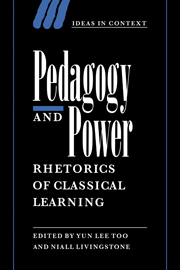Book contents
- Frontmatter
- Contents
- Notes on contributors
- Acknowledgements
- Introduction
- 1 Classics: from discipline in crisis to (multi-)cultural capital
- 2 Schoolboys and gentlemen: classical pedagogy and authority in the English public school
- 3 ‘Die Zung’ ist dieses Schwert': classical tongues and gendered curricula in German schooling to 1908
- 4 ‘What does that argue for us?’: the politics of teaching and political education in late eighteenth-century dialogues
- 5 Women and classical education in the early modern period
- 6 Pilgrimage to Parnassus: local intellectual traditions, humanist education and the cultural geography of sixteenth-century England
- 7 ‘Not so much praise as precept’: Erasmus, panegyric, and the Renaissance art of teaching princes
- 8 Teachers, pupils and imperial power in eleventh-century Byzantium
- 9 Reading power in Roman Greece: the paideia of Dio Chrysostom
- 10 Children, animals, slaves and grammar
- 11 A good man skilled in politics: Quintilian's political theory
- 12 The voice of Isocrates and the dissemination of cultural power
- 13 Xenophon's Cyropaedia: disfiguring the pedagogical state
- Select bibliography
- Index
- IDEAS IN CONTEXT
11 - A good man skilled in politics: Quintilian's political theory
Published online by Cambridge University Press: 30 September 2009
- Frontmatter
- Contents
- Notes on contributors
- Acknowledgements
- Introduction
- 1 Classics: from discipline in crisis to (multi-)cultural capital
- 2 Schoolboys and gentlemen: classical pedagogy and authority in the English public school
- 3 ‘Die Zung’ ist dieses Schwert': classical tongues and gendered curricula in German schooling to 1908
- 4 ‘What does that argue for us?’: the politics of teaching and political education in late eighteenth-century dialogues
- 5 Women and classical education in the early modern period
- 6 Pilgrimage to Parnassus: local intellectual traditions, humanist education and the cultural geography of sixteenth-century England
- 7 ‘Not so much praise as precept’: Erasmus, panegyric, and the Renaissance art of teaching princes
- 8 Teachers, pupils and imperial power in eleventh-century Byzantium
- 9 Reading power in Roman Greece: the paideia of Dio Chrysostom
- 10 Children, animals, slaves and grammar
- 11 A good man skilled in politics: Quintilian's political theory
- 12 The voice of Isocrates and the dissemination of cultural power
- 13 Xenophon's Cyropaedia: disfiguring the pedagogical state
- Select bibliography
- Index
- IDEAS IN CONTEXT
Summary
There are, broadly speaking, two ways of reading Quintilian. One can see him as a type of likeable pedagogue: conscientious and agreeable; perhaps, among the major writers of the first century, not quite first class. This approach is favoured by historians of education and educationalists, some of whom have praised him as ‘doubtless the ideal schoolmaster …’, dwelling on his ‘native good sense’, his ‘prevailing sanity’, even his ‘simple sincere soul’. Alternatively, one can mine him for the information he contains rather than the opinions he expresses. This method has a rather different history, being preferred by a long line of distinguished historians of rhetoric and literary theory.
If the first is largely a diversion, in the double sense that it at once entertains and distracts us from more serious considerations, the second approach is the measure of Quintilian's status as a source for ancient education and particularly for rhetoric. The Institutio Oratoria or ‘Education of the Orator’ is the longest and most detailed educational work to survive from the classical world. In twelve books it takes a learner through every stage of the training of an orator, incorporating on the way a long and detailed rhetorical handbook which matches in importance anything to survive elsewhere in Greek or Latin. If anything, though, Quintilian's descriptions of the pre-rhetorical stages of education are even more to be treasured than the later material.
- Type
- Chapter
- Information
- Pedagogy and PowerRhetorics of Classical Learning, pp. 245 - 262Publisher: Cambridge University PressPrint publication year: 1998
- 52
- Cited by

